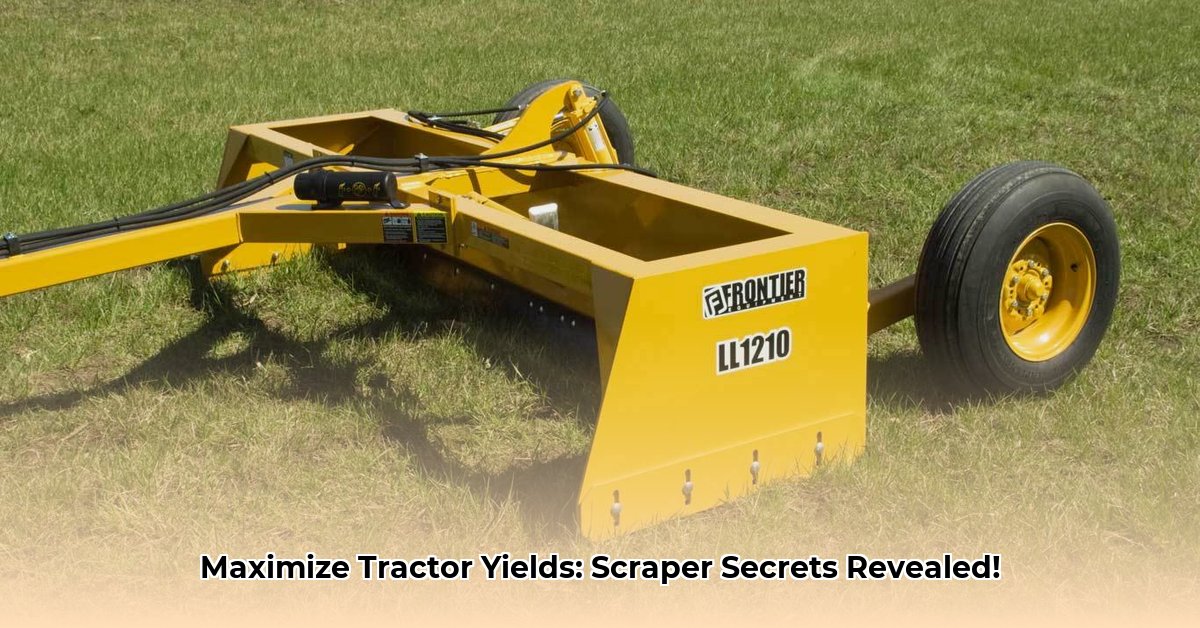
Scraper for Tractor: Optimizing Farm Operations
Boosting farm efficiency begins with the right equipment. A tractor scraper, often overlooked, is a game-changer, saving time and money. This guide provides actionable advice on selecting, maintaining, and innovating with tractor scrapers. Did you know that proper scraper selection can increase land preparation efficiency by up to 20%? Let's explore how. For more on tractor attachments, check out this helpful resource.
Choosing the Right Scraper: Task-Specific Selection
Before purchasing, determine the scraper's intended use. Is it for land clearing, preparing no-till fields, pond construction, or other tasks? The job dictates the scraper type. A small scraper on a powerful tractor is underutilized; a large scraper on a weak tractor will struggle. Matching power and task leads to optimal efficiency.
Soil type is crucial. Sandy soil is vastly different from heavy clay. A scraper efficient in sand will likely bog down in clay. Understanding your soil's properties is critical to purchasing the right equipment. "Choosing the right blade for your soil type is essential for optimal performance and minimizing soil compaction," says Dr. Emily Carter, Agronomist at State University.
Maintaining Your Tractor Scraper: Preventative Maintenance
Regular maintenance is vital. Neglecting your equipment leads to costly repairs. Regularly inspect scraper blades for wear; dull or damaged blades reduce efficiency and can cause accidents. Sharpen or replace as needed. Lubricate moving parts and clean mud or debris to prevent rust. Proper storage extends lifespan. Never underestimate the importance of tightening bolts—loose bolts can cause major problems.
Did you know that routine maintenance can extend the lifespan of a tractor scraper by up to 40%? This translates into significant cost savings over time.
Sourcing Used Tractor Scrapers: Cost-Effective Solutions
Buying used equipment saves money. Online marketplaces and auctions are great starting points. Before purchasing, thoroughly inspect for wear, damage, or repairs. Enquire about maintenance history; hours of use and regular servicing are crucial factors. A little legwork upfront prevents costly future repairs. Investing wisely in used equipment supports your farm's long-term financial health.
Innovation for Manufacturers: Opportunities in Sustainable Design
Manufacturers can innovate by creating sustainable, eco-friendly scrapers from recycled or renewable materials. Scrapers minimizing soil disturbance, key for no-till farming, are another area for growth. "Investing in research and development focused on sustainable materials and reduced soil disturbance presents a significant opportunity for manufacturers," notes Mr. John Miller, CEO of AgriTech Innovations. This resonates strongly with environmentally conscious farmers.
Governmental Support: Incentivizing Sustainable Equipment
Governments can promote efficient and sustainable equipment through incentives like subsidies or tax breaks. Funding research into tillage's environmental impact informs better technology development. Supporting no-till farming-focused scrapers benefits the environment. Policies supporting sustainable practices contribute to long-term land health and farming sustainability.
Tractor Scraper Selection Guide
This table provides a general guideline:
| Tractor Horsepower | Soil Type | Recommended Scraper Size | Considerations |
|---|---|---|---|
| < 50 HP | Light, Sandy Soil | Small | Suitable for light-duty tasks |
| 50-100 HP | Medium Soil | Medium | Versatile for various farm needs |
| > 100 HP | Heavy Clay, Rocky Soil | Large | Essential for heavy-duty applications |
Remember, proper scraper selection directly impacts efficiency and profitability. Consult experienced farmers or equipment dealers for personalized advice.
Optimizing Blade Selection for Sustainable Agriculture
Key Takeaways:
- The right scraper dramatically improves farm efficiency and environmental sustainability.
- Blade material, adjustability, and maintenance are key for maximizing lifespan and minimizing impact.
- Soil type is crucial for selecting the appropriate blade.
- Regular maintenance prevents costly repairs and premature blade failure.
- Sustainable options include recycled or sustainably sourced blades.
- Government incentives encourage the adoption of sustainable equipment.
Matching Blades to Tasks: Understanding Your Farming Operations
Not all scrapers are equal. What works in clay might fail in sandy loam. A box blade excels at leveling; a rear blade, at finer grading. Align blade choice with your specific farm operations.
Blade Materials: Durability and Environmental Considerations
High-quality steel offers durability but consider environmental impact. Look for recycled materials or blades designed for easier recycling. This reduces your environmental footprint and aligns with sustainable agriculture practices.
Size and Compatibility: Achieving Optimal Performance
Proper sizing is paramount. Too small, and you'll prolong the job; too large, and you'll risk tractor damage. Always check manufacturer specifications to prevent errors.
Maintenance: Extending Blade Lifespan
Regular maintenance is essential. Inspect the blade after each use, removing debris. Sharpen or replace worn edges. Lubricate moving parts to prevent corrosion. This translates to long-term cost savings.
Choosing a Scraper: A Step-by-Step Guide
- Assess Needs: What tasks will the scraper perform?
- Analyze Soil: What type of soil do you have?
- Select Blade: Choose one suited to your tasks and soil.
- Prioritize Material: Consider sustainability and durability.
- Check Compatibility: Ensure compatibility with your tractor.
- Maintain: Regularly inspect, clean, sharpen, and lubricate.
Remember, sustainable farming encompasses more than just blades. Minimize soil compaction and consider no-till techniques. A holistic approach is key.